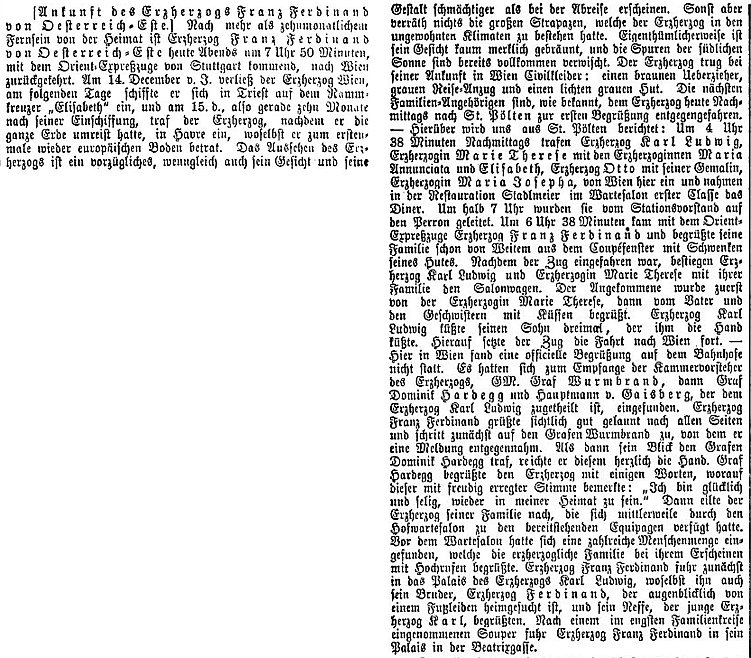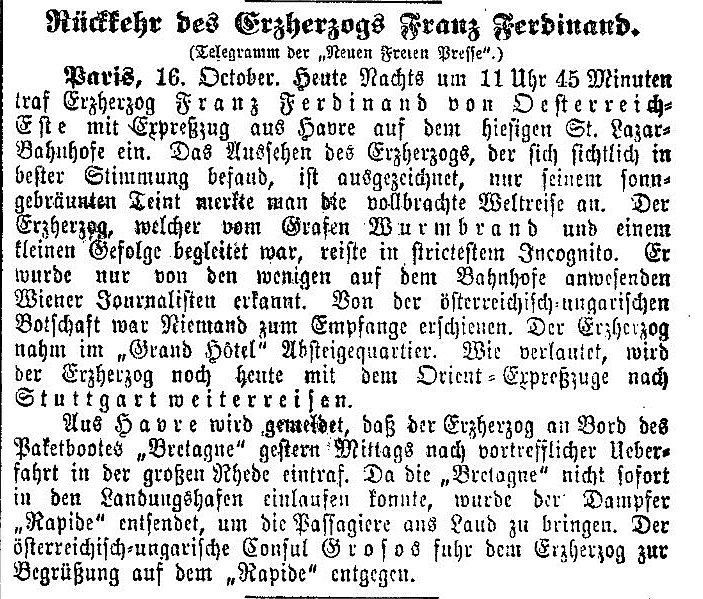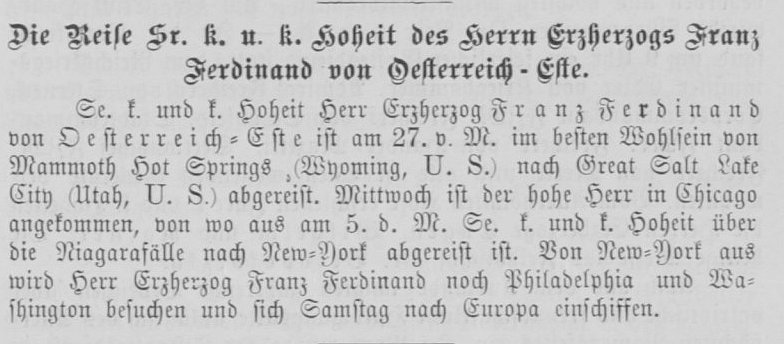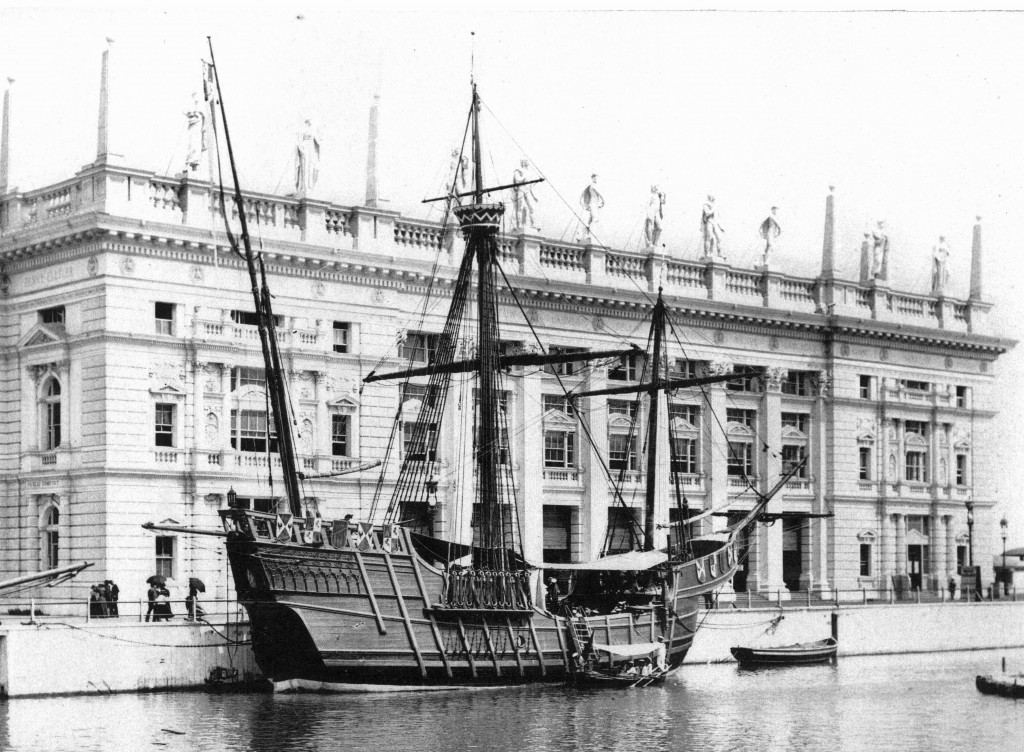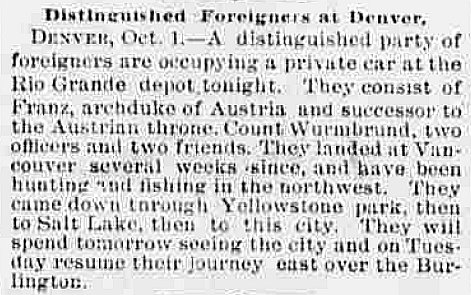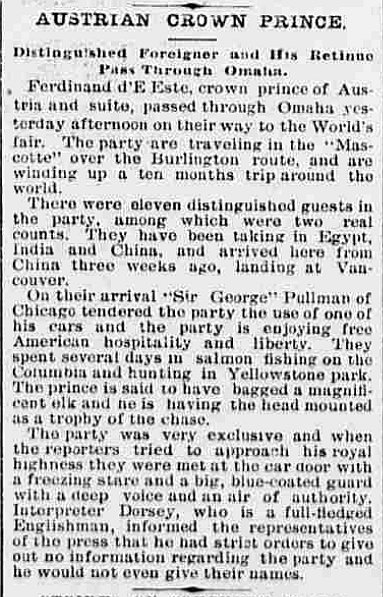A whole row of rail tracks, partly in parallel to our driving direction, partly divergent above or below it, indicated early in the morning that we were approaching Chicago. This colossal railway network is continuously extended. Broad tracks covered with rails are formed; on which the trains drive past one another at great speed, indifferent to whether they are passing through the vibrant city, cultivated land or the prairie. It is amazing that there are not more railroad accidents in view of the complete absence of railroad guards, barriers or other security features as well as a caste of officials who are seldom seen. At home, it would be impossible to send railroad trains at full speed through the streets of populated cities and limit oneself to the sign of the locomotive bell as the only warning signal. If on the one hand there are sometimes made too many efforts at home in terms of personal security and the prevention of accidents and the traveling public is too much patronized, on the other hand, the system so popular here is still too „American“ to be worth copying.
Dirty suburbs, smoking factory stacks and impenetrable smoke clouds that hang over the city were the first impressions that we received during our arrival in Chicago. As I wanted to use the short time of my stay here fully and undisturbed to visiting the exposition, I deemed it necessary to leave the train without being recognized. When I saw a whole army of reporters with the necessary writing equipment in their hands walk towards my Pullman Car guided by an higher railway official in the arrival hall, I rushed through a few wagons and thus managed to escape without being noticed to get a carriage which would take me to the railway to the exposition.
Chicago was the first city of the North American East that I saw. Even though it is by far greater and mightier in its dimensions than the American communities we had visited up to now, I could, however, not find it pleasing. While the suburbs and the more remote districts very much resemble the already described cities in the West, in Chicago’s center, the wooden buildings are replaced by true monsters of houses that are, however, calculated for practical use only and also built without any expenses accommodating a sense of beauty. One house looks like the next one, only the number of floors is different. We saw buildings that had 15, even18 floors but without any ornaments or even the tiniest decorating detail. These giant apartment buildings that consist of a large iron frame with hollow brick fillings are sometimes very narrow in relation to their height which naturally precludes a harmonic effect from the first. Due to the smoke that emerges from the factory smoke stacks the buildings, the roofs and the streets have an unfriendly dark exterior that is still further reinforced by the dark red or brown paint of the buildings.
At the large Auditorium Hotel that forms the corner of Michigan Avenue and Congress street, we took the railway line that led alongside Lake Michigan to the exposition. A double pallisade wall filled in with stone blocks is tasked with containing the waves of the often quite violent lake at the shore but still the tracks of the railway specially built for the purpose of the exposition are often swamped to the height of one foot.
A large crowd was moving to the exposition since the morning hours and was being transported there with steamboats, trains or finally in coaches. The latter are especially popular among the sons of Albion that thus enter the World’s Fair to the sound of the whip and trumpets. The railway sends a train every five minutes; the transfer takes 20 minutes and ends on a wooden viaduct that offers a good overview of the exposition with its sea of halls and galleries, cupolas and towers.
If I want to first present an overall impression that the exposition made on me during my one day visit, I can not deny that it was quite splendid both in extent and arrangement as well in the architectural construction of the main objects. They wanted to surpass all previous expositions which was also achieved in the aspects mentioned. The exposition area of 278 ha is enclosed on three sides by the city and Lake Michigan on the fourth one. The main buildings are imposing by their fabulous size. Likewise the water constructions, the avenues and the traffic installations within the exposition even though the whole territory had been a bare desert a short while ago. Like everything the exposition also had its negative sides: The objects on display do not always fulfil the expectations. The visitor is exposed to much that is unnecessary and old stuff he has often seen before and many things of quite dubious worth. At times one recognizes the desire to fill the enormous large halls at any cost. Thus I found for instance a considerable space filled with badly stuffed animals and anatomical specimens — a transplanted natural history museum here whose reason of existence at this spot was quite questionable. Guided by the intention to present everything in the grandest scale that would only possible to be shown to the astonished world in America, one has sometimes succumbed to impostures that is looking out from under the shiny exterior cover. It can also not be left out to mention that the audience makes a visit to the exposition often not very pleasant by the ruthless behavior, pushing and rushing.
As the already indicated circumstances forced me to devote only a day to visiting the exposition, I intended to see as much as possible but especially the most outstanding buildings, then the sections that interested me most that is forestry and agriculture, ethnography and natural history. Even though a day was insufficient in comparison to the extent of the exposition, we nevertheless were able to get a general impression and managed to see the most important more closely by devoting the necessary effort. Any form of guide I had refused in order not to be dependent on the guide’s will and having to stay in admiration in a soap and perfume exposition due to the guide’s wishes. I thus rushed with the help of a plan to those objects I regarded to be the most worth seeing.
In the children’s pavilion, a spawn of the American need for sensations that lies next to the end point of the train, children in all stages of development from the newborn child to children aged ten or twelve years were on exhibit and the treatment and care of the American child was demonstrated ad oculos. That the rows of babies in cradles not always offers an aesthetic view does not need to be mentioned. Involuntarily I thought about my visit to Moscow where I had to march past the front of 3000 babies and their attending carers in the state orphanage to general hilarity. Naturally I also viewed the exhibited band in Chicago with a bachelor’s view who has obviously different sentiments faced with children than a young mother. Fortunately the exposition committee had made sure that one could see the living objects in their rooms only through large windows and thus the various intimate processes of raising children could usually be kept away from the spectator. Despite of this one had still enough opportunity to study these details closely.
More inspiring to me seemed the garden and fruit exhibition. The garden part is however quite inconsiderable except for the interesting Mexican cacti that were on display in all their varieties and forms. The fruit on view, however, was very remarkable both in quality and quantity. In the matter of cultivating fruit America has done excellent work during recent times, especially California that supplies outstanding fruit is in the lead. Unfortunately the peach and pear harvest of this country was already past. Instead in this nice and neat section a series of the most splendid apple and grape species were on view.
Wooded Island presents a garden criss-crossed by numerous gravel paths whose arrangement seems artificial due to the exaggeration of the art of gardening and offers an impression of tastelessness. Petrol motor boats and numerous other vehicles among them a few Venetian gondolas are driving in the surrounding laguna.
Coming from between the long-winded buildings of the mining and electricity exposition, one enters the main square of the exposition that presents a captivating an imposing view. In the middle of the square is a basin ornamented with fountains and statues on which are numerous boats. Around it rise the mighty buildings of the exposition area that is in effective concord with the architectural structure and exterior ornamentation. It is sad that these splendid building have been designed for only the shortest of time and will outlast the exposition for only a few months, as one can already see some damage on them. Each of these buildings consists of a colossal iron frame with wood fillings that have been plastered over with a very effective looking white stucco-like mass called „staff“. This material, Michigan gypsum with additions of lime and jute fibers was also used to embellish all decorative sculptural works that improve the facades and even for the colossal statue of liberty that is 22 m high.
The most remarkable building is the administration palace crowned by a cupola. In its front stands a statue of Columbus while on its right are the machine then the agricultural halls, to the left are the electricity and the industrial halls. The casino and the music hall complete the square on the lake side.
Out of the basin extend two arms crossed by two mighty bridges of which the Northern one is connected to the laguna and which offer by this branching-off a pleasant spot for the eye to rest. The mentioned statue of liberty whose pedestal is grounded in the basin does not really fit in its gilded decoration and the badly proportioned forms to the imposing surroundings but even seems annoying which not only those with a sense for artistic beauty but also the most enthusiastic republican to whom the Phrygian cap is a holy symbol will admit. More tasteful is the presentation of the Mc. Mounies fountain, a colossal fountain in the form of a triumphal vehicle on which Columbia thrones and allegorical figures guide the rudder. On both sides are illuminated fountains and the basin is enclosed with pillars with animal statues in larger than life dimensions.
The most beautiful view on this great work erected during the shortest of time one enjoys from the bridges over the side canals. Despite the pouring rain and the nourished prejudices I could not refrain from admiring the offered view that was lessened only by the realization that this splendor would exist only for such a short time and not be guarded for the future.
Using the agricultural hall as a covered walkway I went towards the anthropological exposition but saw much on the way there. Thus in the show hall of the extensive cattle and horse exhibition that, by the way, I had heard that it offered nothing exceptional. Passing by numerous wind motors I make a stop at a model of the dwellings of the early cave dwellers of America. A rock has been modeled like nature with all its clefts and fissures and in its interior was a settlement at a smaller scale of those strange humans who ha built homes in caves that are similar to our castles. The cave findings are on display in a nearby museum. Among them are cadavers and human remains in well preserved states of mummification, domestic tools especially pretty clay vessels and flintstone weapons from this prehistoric era.
In the anthropological section I was interested namely in two groups: the Indian exposition and that of the excavations that had been made in all parts of America.The most captivating in the latter group were the findings from Mexico and South America, proof for the high culture and artistic skills of the Aztecs.
Among the exhibited object from Australia and the South Sea islands I recognized many well known objects. Thus a large image of one of the villages of the Papuans at Port Moresby, which vividly reminded me about the eager trade with the natives there. A proof that the grouping of the exhibition objects is not always systematically correct can be seen by the fact that in the anthropological section there were also besides human skulls, arrow heads and other objects from the stone age a sanitary bodice and playing cards from all countries of the world. On the first floor of the building were houses mostly natural history objects among them the life-size model of a mammoth found near Stuttgart. Strangely there were also a few antler and fur traders doing business in this room.
The anthropological is followed by the forestry exhibition that attracted my attention by its varied assortment of wood that come from the various states of America and are demonstratively presented in raw, cut and polished condition. Many of the jungle giants had to die to be shown here as a cut section, and next to the gigantic trunks of spruces an thujas lay also mahogany blocks that have mostly been sent by Mexico. The forestry exhibition is actually not one according to our understanding and I want to contradict the catalogue, despite its audacious claim that there never has been a forestry exhibition of a similar completeness, as there is missing any proof that here reforestation is taken into consideration as a replacement for the plundered forests. Giant trees and likewise cuts alone are not a proof for a rational forestry cultivation. And in many areas it would be necessary, even though North America certainly still ha enormous wood reserves, to care for the regeneration of the mercilessly exploited and devastated forest. Very timidly some of the industries that work with the splendid wood materials are also presenting their objects.
In an open space in front of the pavilion are models of Aztec dwellings and tall, carved idol figures of the Vancouver Indians. Inscriptions describing the horrible deeds of the especially feared Indian chiefs lured us in many of the tents in which we expected to see these novel-like figures or at least the remembrance of them. Instead these inscriptions only served as advertisements for the Indians quite advanced in civilization who offered various goods for sale in their wigwams.
The freight to the exhibition must have cost a fortune for one exhibitor and that is Krupp that has united in a pavilion monster guns, giant ship screws, mighty armor plates, steel cast and forged pieces as well as railway material. Even the transport of these objects from Essen to Chicago is said to have sunk huge sums and now the railway and shipping companies are refusing to undertake the return transport at fair prices, so that Krupp presented the whole exhibit as a present to the city of Chicago. What the peaceful pig raising citizens namely will do with the horrible war tools is however not easy to predict.
The remembrance of Columbus is cared for in the whole exposition which is given proof by a faithful reconstruction of the abbey of Santa Maria de la Rabida where Columbus made a stop on his journey on foot from Palos to Madrid and made the plan there which received the permission of the two kings. The abbey then was owned by the Franciscan order and was under the guardianship of Juan Perez, Queen Isabella’s confessor whose influence did provide important services for Columbus. The monks of Rabida blessed the fleet of the audacious navigator before the departure and blessed it again when the great man returned to the port of Palos after the discovery of America. In the narrow rooms of the reconstructed abbey were exhibited numerous images and reliquaries remembering Columbus but there was such a crowding in there that we could see but little being pushed along by the masses.
On the smooth surface of a basin the model of the „Santa Maria“ was swaying that had been built in the arsenal de la Carracca in Spain and transferred to Chicago. The flagship of Columbus as well as the models of its two compatriots, „Nina“ and „Pinta“ were built according to their true scale and presented themselves as true Spanish ships of their period with a tower-like aft structure as well as a high fore that one is used to see in pictures of the Armada.
The courage of the great Colon who had undertaken the audacious voyage into the unknown sea with such small ships is no less admirable than the astonishing fact that the vehicles managed to withstand the long and stormy ocean journey.
What a contrast is formed by the „Illinois“, the model of a United States warship anchored in Lake Michigan! It had been made in natural scale and completely equipped and manned and armed with all its offensive and defensive weapons. There is also a navy exhibition of the government on board. A dishonorable game contrary to my feelings as a soldier were made here by producing a show every afternoon of the officers and crew on board demonstrating exercises of guns, maneuvering with torpedoes and boats to a gawking crowd that has to pay for attending it. This is not compatible with the earnestness and decorum of being a soldier but demeans it to the level of a rope artist or vaudeville actor. In this country, a soldier does not enjoy the exceptional position and respect that is still assured, God be thanked, in Europe, and thus one may not wonder neither about the public display of the navy nor that on the federal parade ground a larger detachment of the army of the United States performs daily exercised for the spectators.
To recover a bit from the visit of the numerous halls I mounted an electrical train that rushes from the exposition square on a wooden frame and forms loops at its end points. Even though one mostly sees the roofs of the various buildings during this journey, it still offered the opportunity to get a survey of the full giant extent of the exposition area.
At the fishery exhibition — it is housed in a large building of a Spanish-Roman style with a richly developed cupola — we left the train and could quickly see that the content of this beautiful building did not in any way match its exterior wall. Only the aquarium is exceptional, as well as a educative Swedish collection with its boats and fishing equipment. In a large tank of the aquarium were the most diverse freh and salt water fish from the carp to the salmon trout, catfishes, sharks, grotesque devil fishes, lobsters, crawfishes etc.
In the mean time we had developed a giant appetite but had to search for a long time before we found a restaurant whose sign in large letters of „Restaurant francais“ unfortunately did not match with what was offered. At least this had the advantage that we were not at all captured by the culinary delights and could devote our sparsely allocated time again to the exposition.
The industrial hall covering 123.400 m2 is the largest individual building in the world. The iron roof of the hall has a height of 62 m and is borne by 27 main arches with a span of 116 m. In terms of construction material 7.700 t of wood, 5.450 t of steel and 900 t of iron were used. The cost of the building amounted to 1,700.000 dollars. I limited myself to visiting only the Austrian section that displayed much that was remarkable, namely glass, porcelain, leather fashion goods by Förster and other art-industrial objects; for many of our industrial companies however the distance must have been too great and the chance of success too uncertain which I regretted but without feeling resentful.
The rainy weather improved toward the evening and the sun was shining brightly so that there was much activity in the avenues and gardens.
My next destination was the gallery of fine arts, a large middle wing that was united by pillar halls with two annexes to an imposing structure and was decorated with rich ornaments. In the middle of the building rises a colossal statue of Augustus. The art of all European countries is richly represented here and namely Austria’s artists had sent excellent works which I most often greeted as old acquaintances — thus Makart’s „Five senses“, portraits by Angeli, Brozik’s „defenestration“, the well known captivating scene from the Austrian North Pole expedition by Payer, the beautiful deer by Pausinger etc. In one of the rooms stands Her Majesty’s bust in a good likeness. Austria can be proud about this part of the exposition. The art of many other countries is unable to match the works from our home.
The remainder of the evening until the departure of the train I dedicated to Midway Plaisance, the main attraction for every visitor who seeks recovery and entertainment, being tired and awed from the greatness of the exposition. Naturally, everything here too is in giant dimensions as this entertainment venue in the grandest style forms a 2 km long boulevard on whose sides are an innumerable variety of booths, theaters, vaudevilles and restaurants, homes of savage peoples, panoramas etc. I might compare Midway Plaisance to an enlarged and extended Viennese Wurstelprater in which the cosiness and natural humour is replaced by the size and originality of the attractions.
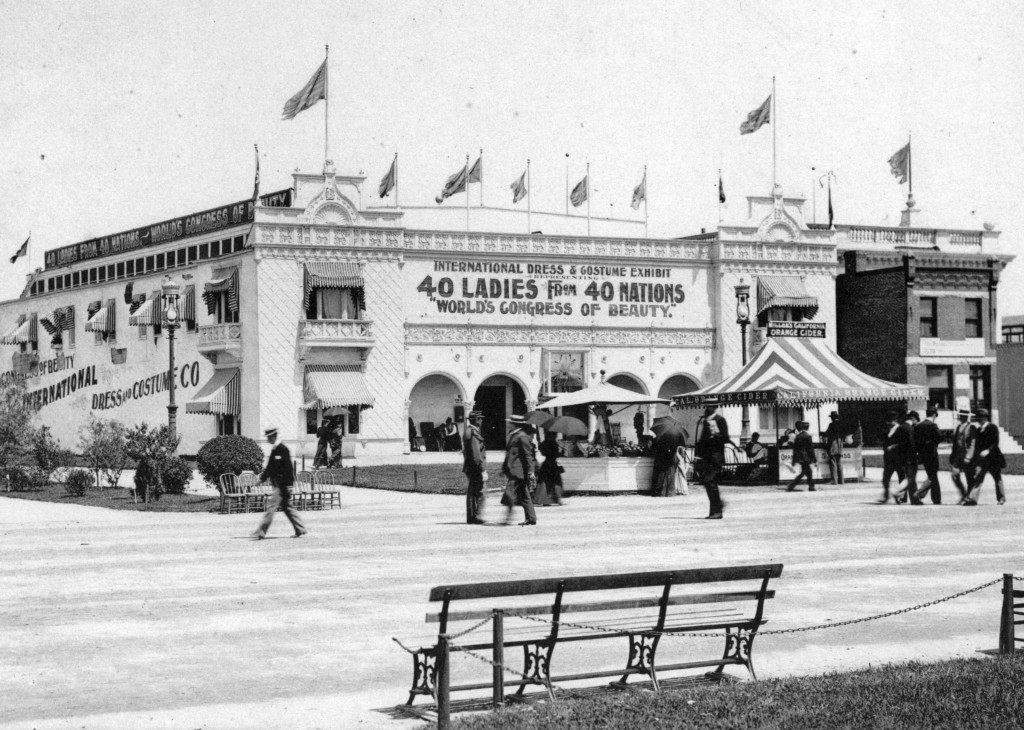
Official Views Of The World’s Columbian The world exposition’s Congress Of Beauty on the Midway (source: Gutenberg.org)
The first pavilion is dedicated to the fair sex and titled „The 40 most beautiful ladies of all nations“. The rush to this much promising building is quite considerable and thus we too took tickets to visit this gallery of living beauties. In small cage-like boxes on a stage sat, were lying or stood women dressed in national costumes representing the different countries whose names were written in large letters below the sections. Here were the Swedish woman next to the fiery eyed Andalusian, the Turk next to the Chinese, the German next to the Japanese etc. to be seen. I could not refrain in the first moment to laugh out loudly as the arrangement of the cages gave the impression of a — sit venia verbo — Menagerie and my hilarity transferred to all those present after even some of the ladies joined in. Some of the „40 most beautiful ladies of the world“ who deemed their task an earnest one and seemed to be infused with the importance of their mission sent scathing glances toward the mocker, the majority however smiled and seemed pleased to have some interruption to the boredom of having to sit quietly and be starred at for twelve hours daily. While not all the ladies, and namely not „Austria“ and „Croatia“, might be counted among the most beautiful of the world, nevertheless some had remarkably pretty faces whose owners certainly merited a better fate.
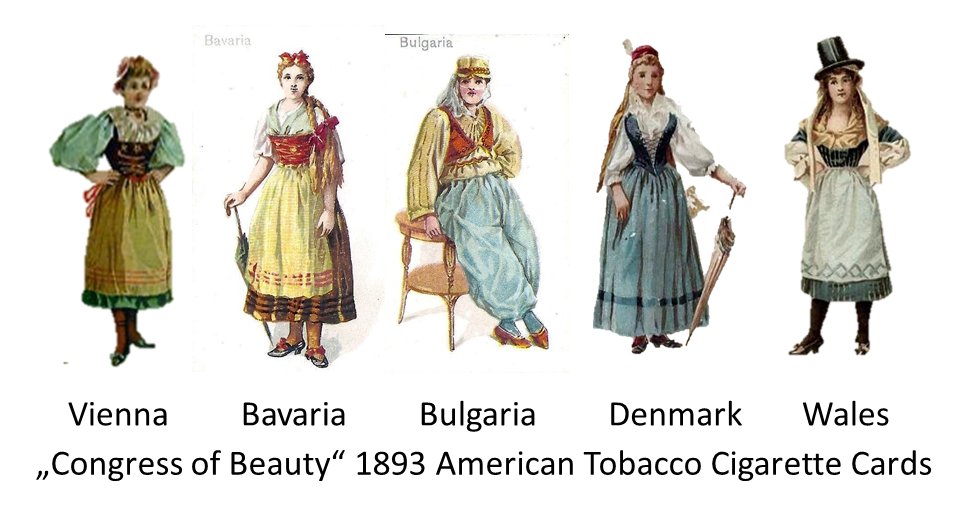
American Tobacco cigarette cards 1893
The Greek woman sitting in the dress of beautiful Helen and in full awareness of her Greek profile sat on an ancient pedestal was recognized as being a former flower girl from Freudenau. Her answers to our questions were true Viennese and filled with the desire of the girl to return soon to her home. Another lady was also from Vienna where she had acted the year before as a champaign serving girl in the music and theater exposition. The Turkish girl who lay with multiple colleagues in an improvised harem on bulging cushions and whose rich costume and the flashy diadem were to complete the illusion seemed to have seen the light of the world in England. The visible joy that the Viennese girls had seeing a compatriot moved me much, but I soon had to escape to be spared a looming spontaneous ovation.
In Hagenbeck’s menagerie, built in circus form, there are daily shows that present quite excellent demonstrations in animal training and therefore attracts numerous spectators without having to use the otherwise so popular form of advertising. Four adult lions followed their tamer like dogs who at the end attached them in front of a wagon and drove around the arena under vivid acclaims by the audience. Also a lion could be seen that was very good at cycling. Remarkable is the peaceful coexistence of various animals in one cage that would pursue and fight one another in liberty. Thus an ice bear with tigers and monkeys, lions with fat pigs, panther with dogs etc. were housed next to each other as neighbors.
We walked from booth to booth some of which we left quite disappointed as the content offered did not match the ballyhooed promises. I did not visit the exotic peoples who I had already personally met in their homeland such as the Papuas. In friendly remembrance of the stay in Java, I had a look at our friend Kerkhoven’s Javanese village that, to my regret, did not seem to offer much attraction.
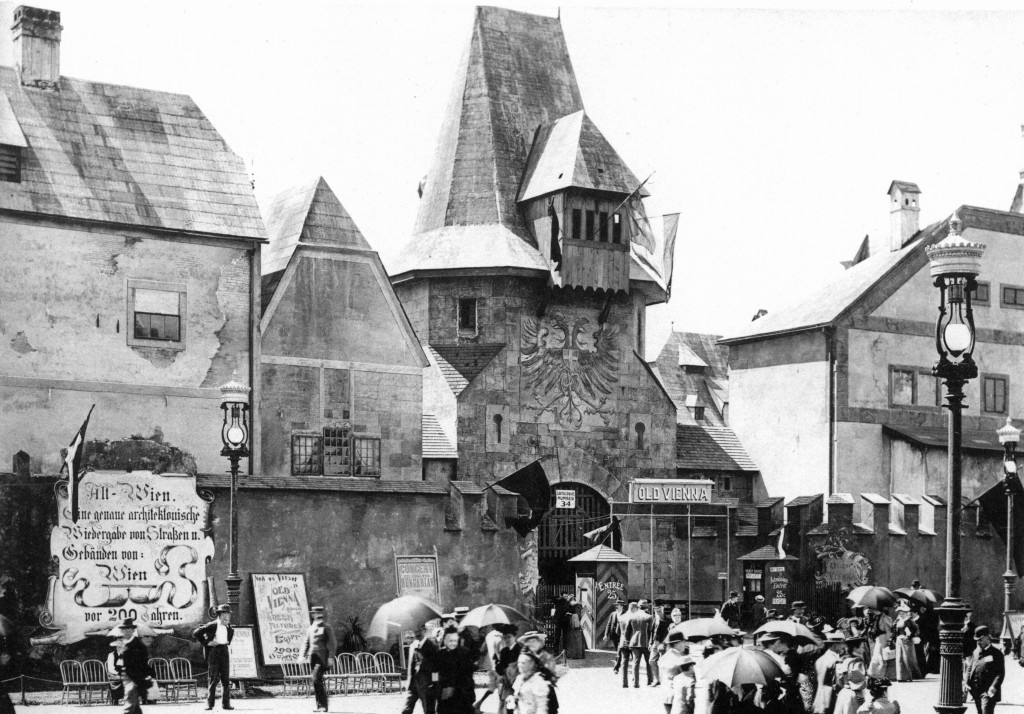
The world exposition’s entrance to Old Vienna, on the Midway (source: Gutenberg.org)
The theater productions all started so late that I could not attend one. Unfortunately I could not visit the much praised „Old Vienna“ given the ambassador’s opinion about certain relations of the Austrian section and had to make do with a pair of the famous Wiener sausages and some rolls that a friend brought to me. It is satisfying to hear that „Old Vienna“ is said to do very good business and that the elegant world of Chicago is meeting here thanks to the excellent productions of Ziehrer as well as the good Viennese cuisine.
To trump the Eiffel tower, a giant reel in the form of a colossal iron wheel had been built on which wagons the size of a Pullmann Car have been attached and go up and down in a vertical circle as soon as the wheel is put into motion by a steam engine. With electrical illumination the iron monster from whose top one can overview the whole exposition presents an impression of a gigantic specter. After a slide also recalled memories of the Viennese Wurstelprater, we felt enticed to see the Lapps who led a quite dirty life in their earth huts and were just eating dinner but seemed to be very pleased about the belated visit.
If the central square in front of the administration building had made a splendid impression during the day, this was the case to a much higher degree at night, as they have masterfully managed to increase the total effect by gleaming and rightly placed illumination. Thousands upon thousands of electric lights that followed the architectural contours and are reflected in the pool have been fixed to the buildings. From the ridge of individual buildings mighty projectors send out their blinding rays into the deep, the gushing cascades and the jets of the spring fountains glow — everything is alight, gleaming and glittering like the decoration of a magic ballet. I did not deem the hard-nosed sense of the Americans capable of orchestrating such a refined and truly beautiful light spectacle.
Returning to our rolling domicile, I finally received the long expected mail that had reached Yokohama with delay and tried to catch up with me all across North America.
Links
- Location: Chicago, Illinois, USA
- ANNO – on 03.10.1893 in Austria’s newspapers.
- The k.u.k. Hof-Burgtheater is playing the comedy „Ein Schritt vom Wege“. The k.u.k. Hof-Operntheater is performing „Wiener Walzer“ and other pieces.

